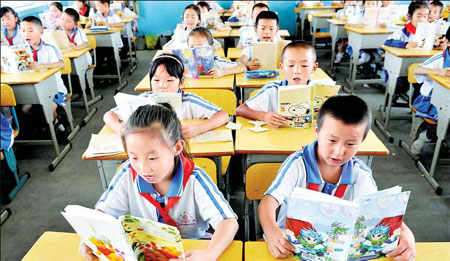|

|
|
Students of No 18 Primary School in Xingqing district of Yinchuan, Ningxia Hui autonomous region, concentrate on a reading lesson yesterday. Wang Peng |
Children of migrant workers will have the same education opportunities as their urban counterparts before the end of this year, the Ministry of Education (MOE) said yesterday.
"The central government will allocate funds to local education departments sufficient to cover extra education expenses in accordance with the number of migrant children they accept," the ministry said on its website.
Fund allocations were previously based on numbers of registered local students, and excluded the children of migrant workers.
The ministry is now drafting policies that provide special bonuses to local education departments that accept non-local children.
"The ministry intends to extend the free education umbrella to cover children from migrant worker families," the ministry spokesperson Xu Mei said.
As from the new semester in next month, urban residents nationwide will be exempted from incidental expenses, making compulsory education totally free in these areas, according to a policy launched earlier this month by the MOE.
Shijiazhuang was the first in the country to provide in 2004 equal education opportunities to children of both local residents and migrant workers through introduction of a unified system of education charges.
Consequently, almost all classes are seriously overcrowded, as 50 or 60 children are generally crammed into classrooms designed for 40 students, Zang Dajian, an education bureau official of Qiaodong district, Shijiazhuang, Hebei province, said.
China provides a nine-year compulsory education system for children aged 6-15, comprising six-year free primary education and three-year secondary education.
The system has long subsisted on government funds and been the privilege of children with local residential certification or hukou, and excluded children living with parents working in cities away from their registered home.
Peng Shengzuo, 40, a construction worker in Beijing, is one example. His 11-year old daughter had to return to his hometown in Shangrao, Jiangxi province because schools in the capital do not accept pupils without a hukou.
As Peng's wife also works in Beijing the family can only be together once a year during the Spring Festival.
In 2007 a total 7.66 million children of migrant workers reached the age at which to start compulsory education, according to statistics.
Most were concentrated in developed areas such as Beijing, Shanghai, Zhejiang and Guangdong provinces.
(China Daily August 27, 2008)